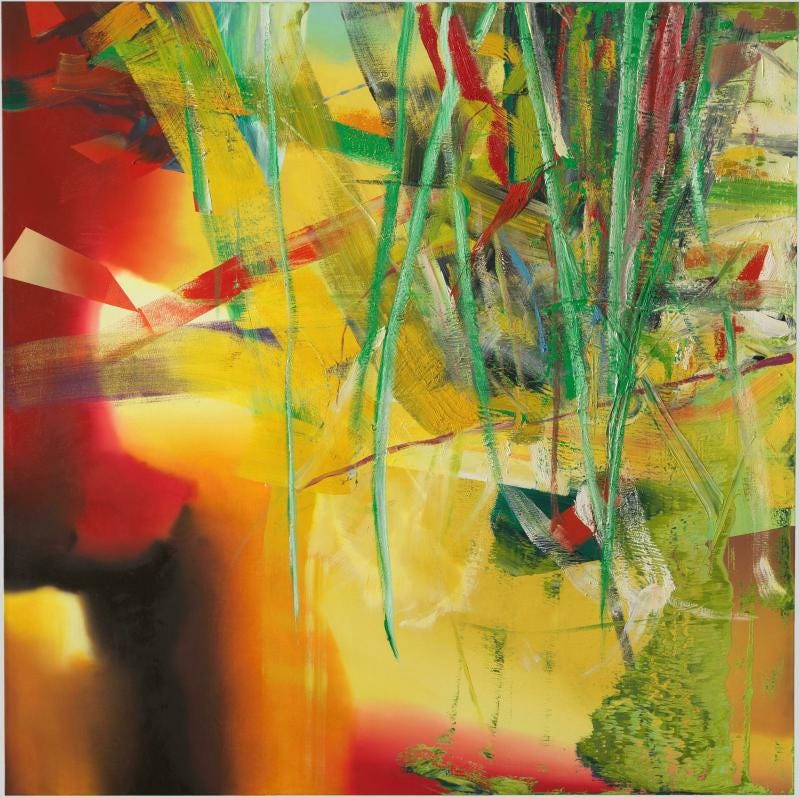Even I, an ardent defender of Modern and Conceptual art, will admit that a lot of it is terrible. Or worse, designed purely to be an expensive tax-write-off for rich people looking to avoid paying their fair share.
I remember walking round the very good show of Abstract Expressionism that was at the RA. 95% of it did nothing for me. Particularly controversially, I don’t find Rothko’s that moving – I don’t get the sense of awe and meditative feeling which other people report. But that remaining 5% has stuck with me far longer than lots of other pieces of art I have seen. Two works stick in my mind. Blue Poles by Jackson Pollock filled me with a strange feeling somewhere between excitement and nostalgia (is nostalgia just excitement in reverse -excitement for the past?) and Franz Kline’s Vawdavitch mesmerized me. I left that show thinking it was brilliant. Two pieces like those were enough to justify a lot of walking around confused and slightly frustrated.
Maybe I’m more tolerant of seeing ‘bad’ abstract art because I find that when abstract things are beautiful, they are unbelievably beautiful. For instance, Gerhard Richter’s Juni is something I fell in love with when I saw it. Whenever I’m in Paris I take a pilgrimage to see it at the Centre Pompidou. The reward of seeing it is worth hours of walking, uninspired, past similar looking paintings which don’t ‘do it’ – whatever ‘it’ is – for me. I feel the same about abstract dance; it’s often nothing but when it’s something it sticks in the mind far longer than more easily legible works.
I saw Yves Klein’s blue recently. I was expecting it to fall into the 95% category of art like this – for it to do nothing for me. I was wrong. It was incredible. I can’t quite describe it. It was the kind of feeling that sits in your collarbones. It’s like an abyss in front of you; your gaze seems to disappear into it. Your eyes begin to lose focus in the way they do in moments of gentle dawn half-sleep.
And what’s more – I can’t explain why. Even with the works discussed above, with Pollock, or Kline, or Richter, I can guess at which parts of the piece have induced certain emotions in me. I could discuss, albeit with inaccuracy and hesitancy, how the angularity of Kline’s pieces means that the viewer imagines his tense physicality while painting it and how this angularity paired with a sense of randomness generates emotions. As I said, with inaccuracy and hesitancy. But with Klein I can’t formulate any explanation of what in it makes me feel the way I felt other than the colour.
It's not that I haven’t seen the shade of blue before. It’s used in lots of pieces of design, most famously in the monochrome look of Fitzcarralado books. But it’s different seeing ‘the real thing’.[1]
I’ve spent a long time thinking about what components make something beautiful. I did an English degree which teaches a forensic, and often reductive, kind of thinking where art objects are dissected and explained. Because of this, or perhaps just because of personality, my style as a theatre director is equally interested in detailed analysis. Often this is useful. With most pieces, it is essential to understand a text with specificity to create performances which are clear to the audience. Clarity being an essential part of making theatre which can move an audience. With Klein’s blue my usual ways of engaging with art don’t work. It’s just beautiful. Or at least I find it beautiful. I can’t explain why. There’s something pure about that, something wonderful about not being able to dissect an art object.
Of course, it is possible to look at works by Yves Klein that use his blue but as a part of something larger - his sculptures with it or the performance Anthropometries[2] - and to do this kind of analysis. That is not my point.
There’s something strange and mysterious for me about Klein’s blue canvas; something, simultaneously terrifying and liberating about seeing a piece of art which I can’t even begin to break down and explain. There’s a purity to that. Some things can’t be reasoned at or intellectualised. To stand in front of Klein blue and to find it beautiful – it is perfectly possible and valid to not, for it to be in your 95% - is to have to reckon with the fact that some things are just mesmeric without having anything we can point at to explain why. Not all beauty can be explained. And then, in the face of art like this, all we can do is surrender to it and experience it.
While writing this I asked a friend and colleague what she thought of Klein’s blue. She replied:
I don’t. I just look at it
There’s wisdom in that. I’m going to try to develop that muscle. To be able to clear my mind and look at artistic objects without any thought, to learn how to ‘just look at it’. Pablo Picasso tells us that:
It took me four years to paint like Raphael, but a lifetime to paint like a child.
I wonder how long it will take me to learn to look like a child, free from the critical gaze and the often emotionally blunt tools of analysis. I wonder what beauty I may be able to see but not explain. Yves Klein’s blue is a good place to start.
[1] This raises so many complicated semantic and ontological questions I won’t even begin to interrogate it.
[2] As it happens I don’t have much to say about Anthropometries. It falls into that 95% category of abstract art that doesn’t do ‘it’ for me. I think it’s self-indulgent and falls foul of using a problematic kind of male-gaze.





